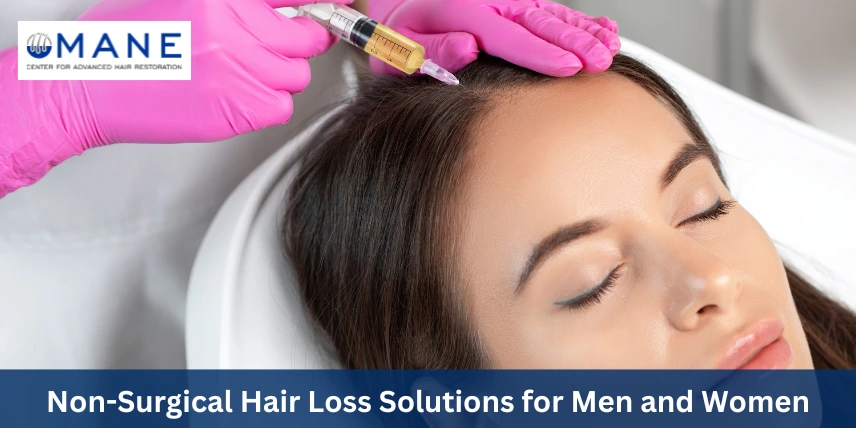


Hair loss affects millions of men and women, often taking a toll not just on appearance but on confidence and self-esteem. While surgery was once the go-to solution, modern non-surgical treatments are now leading the way. From stimulating hair regrowth to creating the illusion of density, today’s non-invasive options combine technology and science to restore hair health without invasive procedures.
Discover how today’s non-invasive hair loss treatments can help you regain hair and confidence, without surgery.
Hair loss can result from various factors, including:
Early signs to watch for include a thinning crown, widening part, receding hairline, or increased hair shedding. Spotting these symptoms early allows for timely, non-invasive hair loss treatment that can preserve and even regrow hair.
Non-surgical hair restoration offers numerous advantages:
These hair thickening solutions are ideal for those looking for gradual, realistic enhancement without the commitment or recovery associated with surgery.
Here are the most popular and effective options available today:
PRP therapy harnesses your own blood’s growth factors to stimulate dormant follicles and encourage hair regrowth. After drawing a small blood sample, it’s processed to concentrate platelets, which are then injected into the scalp.
SMP is a cosmetic procedure where pigment is deposited into the scalp to mimic the look of hair follicles.
LLLT uses red light technology to enhance blood flow and stimulate follicle health.
Medical therapies like Minoxidil (topical) and Finasteride (oral) help reduce shedding and support regrowth.
Many patients benefit from a tailored approach that combines treatments based on their unique needs.
Non-surgical hair regrowth solutions are ideal for individuals in the early to moderate stages of hair loss or for those who prefer gradual, low-risk treatments.
Surgery may be recommended when:
That said, starting with non-surgical therapies can delay or even eliminate the need for surgery.
Hair loss patterns differ significantly between men and women:
Hormonal fluctuations, pregnancy, and menopause also impact women differently. That’s why personalized evaluations and plans are critical for the success of any hair restoration without surgery.
Each non-invasive treatment varies slightly in process and recovery:
Post-treatment, maintaining scalp health, reducing stress, and following prescribed regimens help prolong results.
Getting back fuller, healthier hair doesn’t have to mean going under the knife. Today’s non-surgical options make it easier than ever to treat hair loss with personalized care that fits your lifestyle. From PRP and laser therapy to expert-guided regrowth plans, real results are within reach. Take the first step toward feeling confident in your hair again, because change starts the moment you decide to take action.
Why wait for your hair to get worse? At Mane Center for Advanced Hair Restoration, we specialize in non-invasive solutions tailored to your needs. Let us guide you with expert care and customized treatments that bring out your best.
Schedule your consultation today and take the first step toward renewed confidence.
Non-surgical treatments like PRP therapy, low-level laser therapy, and FDA-approved medications have demonstrated positive outcomes in slowing hair loss, improving hair density, and stimulating regrowth, particularly when started during the early stages of hair thinning.
Individuals experiencing early to moderate hair thinning, diffuse hair loss, or those seeking gradual, natural-looking results without the risks or downtime of surgery are typically well-suited for non-surgical solutions.
Many non-invasive options are designed to work across genders, though treatment plans are often customized to account for hormonal differences, hair loss patterns, and specific medical histories unique to men and women.
The timeline for visible results varies depending on the treatment method. PRP and medications may take 3–6 months, while laser therapy and other programs require consistent, long-term use to achieve and maintain improvements.
By addressing thinning early and preserving existing follicles, non-surgical treatments can significantly reduce the urgency or necessity of hair transplant surgery, offering a less invasive path to hair restoration for many individuals.